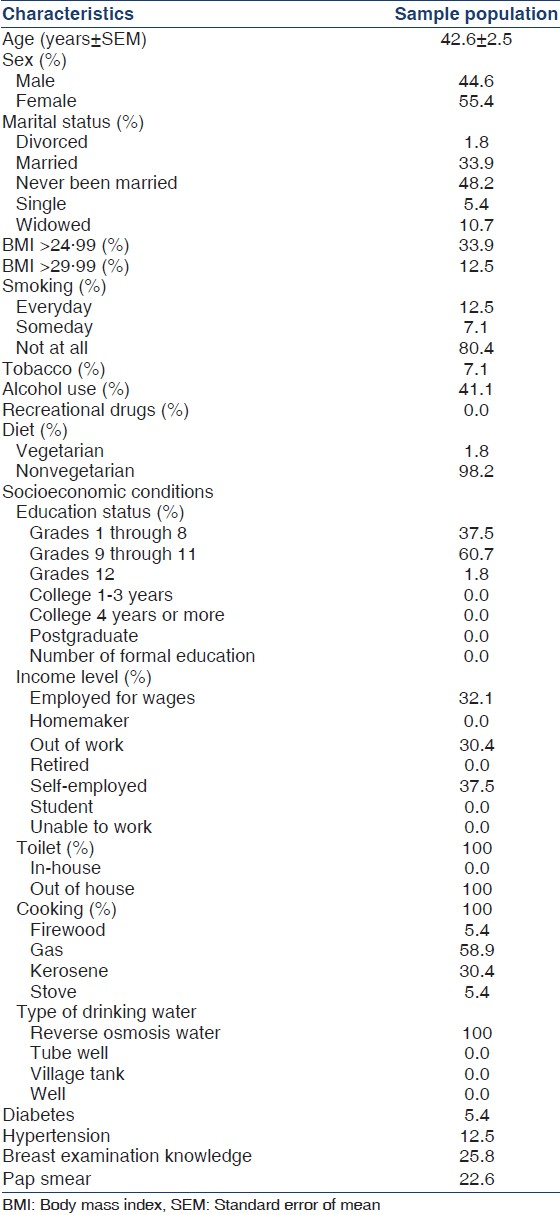Translate this page into:
Incidence of diabetes and hypertension in indigenous Amerindian village in Guyana, South America
Address for correspondence: Dr. R. M. Jindal, Department of Surgery, Uniformed Services University of Health Sciences and Walter Reed NNMC, 8901 Wisconsin Av, Bethesda, MD 20889, USA. E-mail: jindalr@msn.com
This is an open access article distributed under the terms of the Creative Commons Attribution-NonCommercial-ShareAlike 3.0 License, which allows others to remix, tweak, and build upon the work non-commercially, as long as the author is credited and the new creations are licensed under the identical terms.
This article was originally published by Medknow Publications & Media Pvt Ltd and was migrated to Scientific Scholar after the change of Publisher.
Sir,
We carried out a detailed survey of the adult population in the remote Amerindian indigenous village (Santa Mission) Guyana, South America. The village is home to approximately 200 people of mainly Arawak descent, where there is no health care.[1] The approximately 740,000 people living in the country is made up out of Amerindians (5.3%), Blacks (30.5%), East Indians (51.4%), Chinese (0.2%), White (2.1%), and Mixed (10%).[1] Population mix of the country lends itself to anthropological, social, lifestyle, and genetic studies which may yield important information.[2]
We previously reported our pilot data in which we screened 619 people in Guyana.[3] This work was part of the SEVAK Project in Guyana and India.[4]
There were several similarities in the characteristics of the Amerindian indigenous people and the nonindigenous people. There was no difference in the age, marital status, access to clean drinking water, incidence of smoking, alcohol use, or drug abuse. None of the homes had indoor toilets while 83.6% had indoor toilets in the nonindigenous people. The prevalence of diabetes mellitus was 13.9%, and that of hypertension was 29.4% in the nonindigenous group versus 5.4% and 12.5%, respectively, in the indigenous group [Table 1].

We were intrigued by the prevalence of diabetes and hypertension in the two groups. The low incidence of these conditions could be attributed to a variety of reasons such as nomadic lifestyle, genetic, or unknown factors. The incidence of obesity between the two groups was similar. This is in contrast to the high incidence of diabetes and hypertension in the native American-Indians in the US.[5]
Financial support and sponsorship
Nil.
Conflicts of interest
There are no conflicts of interest.
References
- National Report on Indigenous Peoples and Development United Nations Development Programme, Country Office: Guyana. Available from: http://www.hartford.hwp.com/archives/41/318.html
- Population genetics, history, and health patterns in native Americans. Annu Rev Genomics Hum Genet. 2004;5:295-315.
- [Google Scholar]
- Diabetes, hypertension, sanitation and health education by high school students in Guyana, South America. Indian J Nephrol [Epub ahead of print]. Available from: http://www.indianjnephrol.org/preprintarticle.asp?id=161522
- [Google Scholar]
- SEVAK Project in India and Guyana Modeled After the Independent Duty Corpsman of the U.S. Navy. Mil Med. 2015;180:1205-6.
- [Google Scholar]
- Cardiovascular health among American Indians and Alaska Natives: Successes, challenges, and potentials. Am J Prev Med. 2005;29(5 Suppl 1):11-7.
- [Google Scholar]






